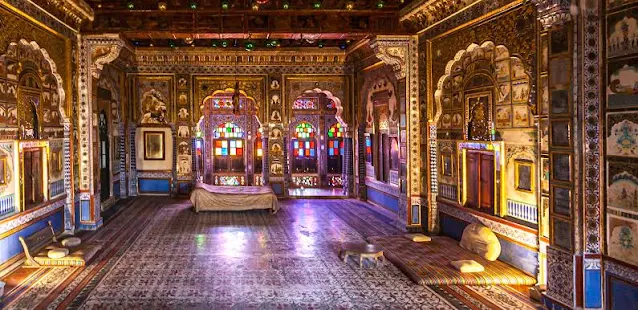Exploring the Rich Culture and History of Rajasthan
The Mighty Mehrangarh, the muscular fort that towers over the Blue City of Jodhpur, is a magnificent spectacle and an architectural masterpiece. It has a 16th-century city wall. Inside is a tangle of winding, glittering, medieval streets, which never seem to lead where you expect them to be scented by incense, roses, and sewers, with shops and bazaars selling everything from trumpets and temple decorations to snuff and saris.
Jodhpur stretches well beyond the city walls, but the immediacy and buzz of the old Blue City and the larger-than-life fort capture the imagination. This crowded zone is also the main tourist area. Areas of Jodhpur further west, such as Navchokiya, are just as atmospheric but far less hustle and bustle. Mehrangarh Fort is an iconic castle, soaring 125 meters high and attracting visitors from all over.
Mehrangarh Castle:
On a vertical cliff, four hundred feet above the Jodhpur skyline, the Mehrangarh Fort rises a hundred feet in majesty. The beauty of this red sandstone is unbreakable. The Mehrangarh Fort in Jodhpur, which sits atop a rocky hill 400 feet above the plain below, appears to command and fit in with the surroundings. We said much about the Citadel of the Sun, undoubtedly one of the most stunning structures. Its scale is so massive that Rudyard Kipling dubbed it the creation of giants. We recognize it as one of the best-preserved forts.
 |
| Mehrangarh Fort Jodhpur Rajasthan |
It is one of the largest castles in India. They constructed everything but the stone, although it was from wood. It is one of the largest forts, with some of the most beautiful palaces and a museum housing many rare antiques from Indian courtly life. Rathores ruled here for five centuries. Mehrangarh Castle is the most crucial structure, with a regnant view of the blue. In the sunshine, the colours of the desert are slightly dull. The construction of the fortress began in 1459 under Rao Jodha's rule. Before entering the castle, you must first pass through seven gates. We can check bullet traces as you get to the fifth gate. In the museum, you may enjoy Sheesh Mahal, Phool Mahal, Takhat Vilas, Sardar Vilas, Jhanki Mahal, Dipak Mahal, and Moti Mahal as the seven-period rooms, and Howdah Gallery, Palanquin Gallery, Daulat Khana, Painting Gallery, Textile Gallery, and Arms Gallery as the six galleries.
JASWANT THADA
This milky white memorial, created as a tribute to Jaswant Singh at the end of the 19th century, is a prime tourist destination. The ruler of Jodhpur, Jaswant Singh, put a lot of money into his domain. In honour of the 33rd Rathore ruler of Jodhpur, Maharaja Sardar Singh built it in memory of his father, Maharaja Jaswant Singh II. He attempted to reduce crime, apprehended dacoits, built railways, and improved the economy. Its gardens provide a tranquil setting for morning music. Its grounds serve as a serene venue for morning concerts during music festivals such as the Rajasthan International Folk Festival and the World Sacred Spirit Festival.
THE UMAID BHAWAN PALACE
A visit to Jodhpur is incomplete without seeing the beautiful Umaid Bhawan Palace. This palace, built by Maharaja Umaid Singh in 1929, is one of the largest private mansions. The only component of the magnificent palace open to the public is the royal residence, which includes a luxury hotel and a family museum. The museum has a beautiful collection of vintage memorabilia that will take you through the intriguing history of the Jodhpur kings in the twentieth century. The architect used stones taken from Chittar Hill as the Chittar Palace. It was under construction. H.V. Lanchester, a well-known British architect, designed the palace, which took 16 years to complete. The architecture is a mix of Indo-Saracenic, Classical Revival, and Western Art Deco styles, and they use unique sandstone and marble. It is one of the largest private residences in the world and one of the most beautiful structures. It is the only 20th-century palace.
 |
| Umaid Bhawan Palace |
RANISAR PADAMSAR:
There are twin lakes in Mehrangarh called Ranisar and Padmasar, built in 1459. They built Ranisar Lake on the orders of Queen Jasmade Hadi, Rao Jodha’s wife, and Queen Padmini of Rao Ganga, daughter of Rana Sanga of Mewar, who ordered Padmasar Lake. For a sightseer, the beautiful sunrise from the back of Fort Mehrangarh and the sunset from the other side of the range will be the most exciting sights for a visitor to this metropolitan attraction. The tranquil panorama along the water's edge, especially with the fort looming nearby may charm you.
 |
| Ranisar Padamsar Lakes, Jodhpur |
SHEESH MAHAL:
The glass palace of Jodhpur, also known as the Sheesh Mahal, is within the Mehrangarh Fort compound. The mirrors adorning it reflected plaster casts of vibrantly painted religious images. They embellished the walls of this spectacular structure, stretching from the ceilings to the ground.
 |
| Sheesh Mahal Jodhpur |
Jodhpur, the Blue City, is a mesmerising blend of history, culture, and architectural brilliance. With its cobalt-blue houses set against the mighty Mehrangarh Fort, the city exudes an unmatched charm. Strolling through its bustling bazaars and winding lanes offers a glimpse of Rajasthan’s vibrant traditions. As the sun sets, Jodhpur glows with a timeless allure, leaving every traveller captivated. It’s not just a place to visit but a vivid journey into the heart of Rajasthan’s soul.